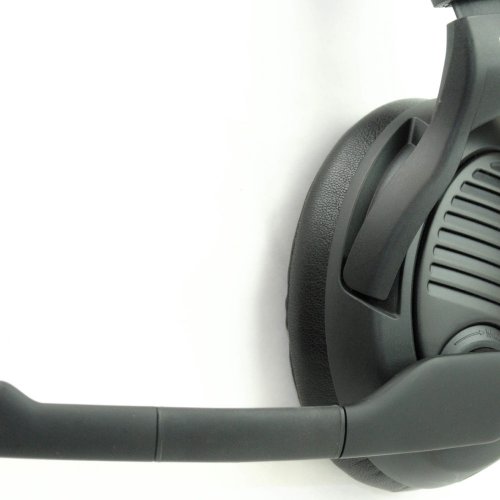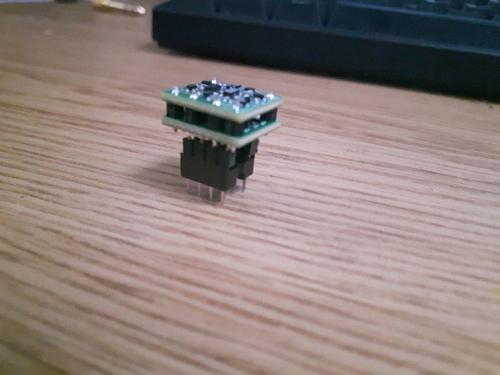Dekoni Audio Choice Leather Earpads For Sennheiser PC37X/HD598
Intro
Whenever we're talking about aftermarket headphone parts, we usually talk about cables.
With dozens of companies to choose from and prices ranging from 'pocket change' to 'holy crap that's a stereo' one can be certain that regardless of what headphones you own and how deep your wallet is, your needs will be met.
But with earpads it's a quite a different story.
Manufacturers don't offer any choice when it comes to material and filling selection. You're stuck with whatever came in the box with only replacement being whatever some other manufacturer put on their headphones that just happends to fit yours too.
This is exactly the niche in the headphones market Dekoni addresses. They offer a wide selection of headphones that fit most mid to high end models on the market with multiple materials to choose from. Whether you own a $100 or a $1000 headphone, Dekoni offers at least a few different earpad models to choose from.
Disclaimer
The earpads were sent over for free for review, no other compensation was offered or implied.
Aside from owning another pair of Dekoni earpads I am not affiliated with Dekoni in any way.
All listening tests were done using either a Fiio M11, Creative X7 or straight out of my laptop (when used for conference calls).
Please keep in mind that this is not a Sennheiser PC37X review and I will only be describing differences caused by earpad swap and not the headset itself. If you are curious about the quality of the PC37X there are plenty of reviews on the Internet (including my own).
Packaging
Earpads are delivered in a small, lacquered cardboard box with a Dekoni logo on top.
Box is durable enough to survive getting dropped on the floor and the magnetic seal prevents it from opening on accident.
I highly recommend not throwing the box away as it is perfect for storing small electronics (such as cables, adapters or IEM tips).
Build Quality
Jump in quality between stock earpads and Dekonis is clearly noticeable here.
Instead of velour which sometimes may feel a little rough to the touch we get nice, soft, silky smooth leather that's delightful to touch. Honestly, I never had a problem with how stock earpads feel when pressed against my head, but after I compared them to the Choice Leather they just started to feel unpleasant. You know, like in that episode of HIMYM where Marshall and Lily went to view a house and afterwards their apartment started to feel cramped and tiny.
Filling material is also different, on stock earpads it's firm and springy whereas on Dekonis it's soft and mushy. Dekoni calls this 'ultra slow rebound memory foam' and while the name may not be the catchiest it does accurately describe how it works. Seriously, after you press on the pads with your finger it takes a good few seconds for the foam to return back to its original shape. And it looks awesome, like watching regular pads in slo-mo.
Comfort
PC37X is already a pretty comfy headset on its own but the earpad swap made it even comfier.
Thanks to softer filling material pressure is more evenly distributed on the skull instead of pressing right in front and behind your ear like the stock earpads do.
However you need to keep in mind that leather earpads have a tendency to cause additional sweating and irritation of the skin in hot weather.
I can't really test whether that happens using this specific pair because, well it's November but it's something you should keep in mind before you decide to swap you pads especially if you live in warmer climate.
Isolation
Softer filling material (and the leather) both contribute to better seal and thus, slightly better isolation. It's not a night and day difference, PC37X as well as HD5XX series are still open back headphones after all, but if stock PC37X was 2/10 when it comes to isolation, PC37X with Dekoni leather earpads is 3/10.
Sound (Games)
Sound signature went through a significant change after swapping the pads and depending on how you use your Sennheisers it may not be a welcome one.
Soundstage is smaller compared to stock earpads which will make locating sounds in 3D space harder and midbass got boosted which will obscure the sounds of footsteps. Not an ideal combination for competitve gaming. However if casual/immersive gaming is more of your thing then added bass may be a welcome improvement as it will definitely make all those 'splosions and engine sounds more fleshed out.
Whether the tradeoff is acceptable is up to you though.
Sound (Music)
Funnily enough, while for gaming choosing between stock pads and the leather ones is a tradeoff with no clear winner, for music it's pretty much a nobrainer.
Bass quantity has been a major shortcoming of the HD5XX series since its beginning and it was one of my only complaints back when I used HD598 as my daily driver. With the Dekoni leather pads the bass gets punchier and very slightly boomier. The pads won't magically transform your headphones into bass cannons, the difference isn't that big but it's a nice tweak. Like turning on bass boost on iFi products. Granted, nobody is going to buy PC37X specifically as a music headphone but if you happen to already own one and don't have budget for another pair then an earpad swap might be exactly what you need.
Recommendations
For 100% Competitive Gaming?
No. If the only thing you use your HD598/PC37X for is pwning noobs then changes brought by the Dekoni leather pads are the exact opposite of what you need.
For Casual/Immersive Gaming, Music Or Conference Calls?
Heck yeah! Comfort improvement enough is the reason to buy those with isolation and bass being an unexpected but welcome bonus. Seriously it's so good I put another pair of Dekoni pads (for my Focals) on my to-buy list. It's just that big of an improvement.
Intro
Whenever we're talking about aftermarket headphone parts, we usually talk about cables.
With dozens of companies to choose from and prices ranging from 'pocket change' to 'holy crap that's a stereo' one can be certain that regardless of what headphones you own and how deep your wallet is, your needs will be met.
But with earpads it's a quite a different story.
Manufacturers don't offer any choice when it comes to material and filling selection. You're stuck with whatever came in the box with only replacement being whatever some other manufacturer put on their headphones that just happends to fit yours too.
This is exactly the niche in the headphones market Dekoni addresses. They offer a wide selection of headphones that fit most mid to high end models on the market with multiple materials to choose from. Whether you own a $100 or a $1000 headphone, Dekoni offers at least a few different earpad models to choose from.
Disclaimer
The earpads were sent over for free for review, no other compensation was offered or implied.
Aside from owning another pair of Dekoni earpads I am not affiliated with Dekoni in any way.
All listening tests were done using either a Fiio M11, Creative X7 or straight out of my laptop (when used for conference calls).
Please keep in mind that this is not a Sennheiser PC37X review and I will only be describing differences caused by earpad swap and not the headset itself. If you are curious about the quality of the PC37X there are plenty of reviews on the Internet (including my own).
Packaging
Earpads are delivered in a small, lacquered cardboard box with a Dekoni logo on top.
Box is durable enough to survive getting dropped on the floor and the magnetic seal prevents it from opening on accident.
I highly recommend not throwing the box away as it is perfect for storing small electronics (such as cables, adapters or IEM tips).
Build Quality
Jump in quality between stock earpads and Dekonis is clearly noticeable here.
Instead of velour which sometimes may feel a little rough to the touch we get nice, soft, silky smooth leather that's delightful to touch. Honestly, I never had a problem with how stock earpads feel when pressed against my head, but after I compared them to the Choice Leather they just started to feel unpleasant. You know, like in that episode of HIMYM where Marshall and Lily went to view a house and afterwards their apartment started to feel cramped and tiny.
Filling material is also different, on stock earpads it's firm and springy whereas on Dekonis it's soft and mushy. Dekoni calls this 'ultra slow rebound memory foam' and while the name may not be the catchiest it does accurately describe how it works. Seriously, after you press on the pads with your finger it takes a good few seconds for the foam to return back to its original shape. And it looks awesome, like watching regular pads in slo-mo.
Comfort
PC37X is already a pretty comfy headset on its own but the earpad swap made it even comfier.
Thanks to softer filling material pressure is more evenly distributed on the skull instead of pressing right in front and behind your ear like the stock earpads do.
However you need to keep in mind that leather earpads have a tendency to cause additional sweating and irritation of the skin in hot weather.
I can't really test whether that happens using this specific pair because, well it's November but it's something you should keep in mind before you decide to swap you pads especially if you live in warmer climate.
Isolation
Softer filling material (and the leather) both contribute to better seal and thus, slightly better isolation. It's not a night and day difference, PC37X as well as HD5XX series are still open back headphones after all, but if stock PC37X was 2/10 when it comes to isolation, PC37X with Dekoni leather earpads is 3/10.
Sound (Games)
Sound signature went through a significant change after swapping the pads and depending on how you use your Sennheisers it may not be a welcome one.
Soundstage is smaller compared to stock earpads which will make locating sounds in 3D space harder and midbass got boosted which will obscure the sounds of footsteps. Not an ideal combination for competitve gaming. However if casual/immersive gaming is more of your thing then added bass may be a welcome improvement as it will definitely make all those 'splosions and engine sounds more fleshed out.
Whether the tradeoff is acceptable is up to you though.
Sound (Music)
Funnily enough, while for gaming choosing between stock pads and the leather ones is a tradeoff with no clear winner, for music it's pretty much a nobrainer.
Bass quantity has been a major shortcoming of the HD5XX series since its beginning and it was one of my only complaints back when I used HD598 as my daily driver. With the Dekoni leather pads the bass gets punchier and very slightly boomier. The pads won't magically transform your headphones into bass cannons, the difference isn't that big but it's a nice tweak. Like turning on bass boost on iFi products. Granted, nobody is going to buy PC37X specifically as a music headphone but if you happen to already own one and don't have budget for another pair then an earpad swap might be exactly what you need.
Recommendations
For 100% Competitive Gaming?
No. If the only thing you use your HD598/PC37X for is pwning noobs then changes brought by the Dekoni leather pads are the exact opposite of what you need.
For Casual/Immersive Gaming, Music Or Conference Calls?
Heck yeah! Comfort improvement enough is the reason to buy those with isolation and bass being an unexpected but welcome bonus. Seriously it's so good I put another pair of Dekoni pads (for my Focals) on my to-buy list. It's just that big of an improvement.






































